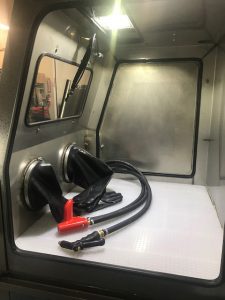
A question we hear occasionally is, “Does my water source affect the wet blasting process?”
Some shops are hooked up to city tap water. Others use spring or well water. The concerns that we hear is that chemicals in tap water, or minerals in well water may affect the wet blasting process, diminishing the results of wet blasting.
To set all concerns to rest, the water source usually doesn’t make a big difference.
There is a specific “edge case” in which the water source and abrasive interact in such a way that the pH of the water is changed, which we will talk about below.
Understanding the pH of Water
Most water, whether it comes from a well, from a natural spring, or out of a tap, has a pH of right around 7.
When water has a pH of 7, that means the pH is perfectly neutral.
If the pH level of the water drops below 7, it is described as acidic. When the pH rises above 7, then the water is described as basic.
Acidic water has more hydrogen ions than neutral water, and basic water has less hydrogen ions than neutral water.
How Do I Know If My Water is Too Acidic or Basic?
If you are wet blasting aluminum, stainless steel, chrome, or steel parts, and the finished part comes out looking discolored, you may have a pH problem with the water.
Usually, your part will come out with a slight purplish or brownish tinge if this is the case.
What causes this pH imbalance?
This is usually not caused by your water source. In almost every case, this is a result of the specific abrasive and water having a chemical reaction that changes the pH. Where and how the abrasive is manufactured is usually the root cause of this reaction.
As we previously mentioned, this is an extremely rare occurrence.
But how do you solve this situation?
Testing pH and Changing the pH Balance
To determine whether the water/abrasive mix is causing a pH imbalance, use a pool pH testing kit. Ideally, your water pH will be around 7.1 to 7.2.
You can use sodium bicarbonate to raise acidic water back to a neutral balance, right around 7. You can also use water treatment found at a pool supply store to adjust the acidity or alkalinity to an acceptable level. If you are using a pool water treatment, use small amounts to test using a testing strip, as a little bit of these chemicals goes a long way.
Summary
To recap, most water sources, whether it’s city water or well water, will be okay for wet blasting. In the rare case that you have discoloration during the wet blasting process, it is likely caused by a chemical reaction between the water and abrasive. To solve the problem, and bring the pH of the water back to a neutral balance, use sodium bicarbonate (if acidic) or a pH Up or pH Down pool supply product (if basic or acidic).
